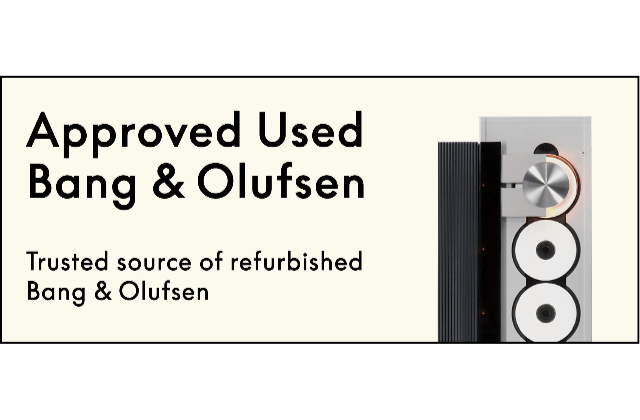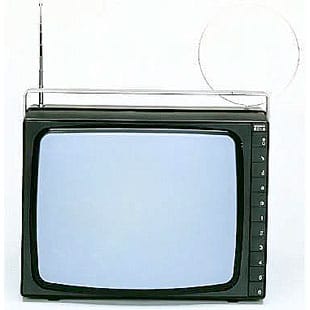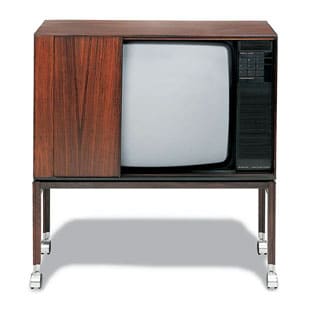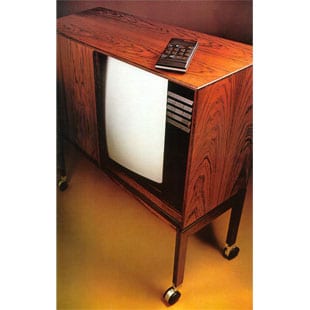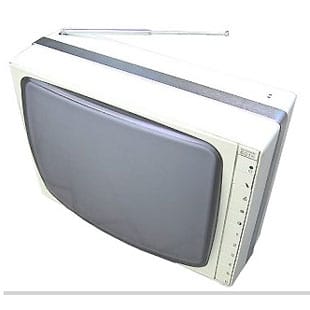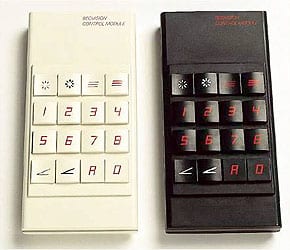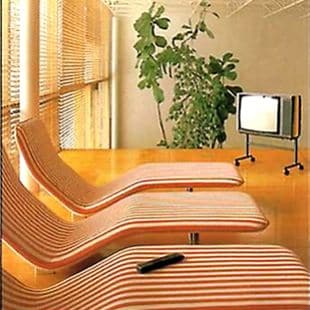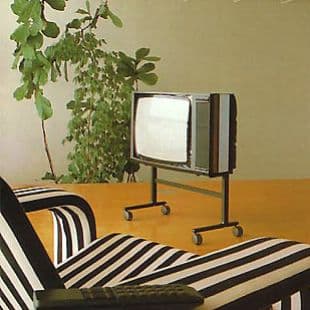BeoVision 6-26
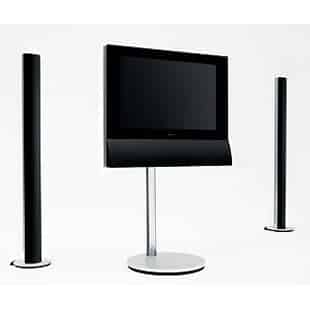
BeoVision 6-26
LCD technology makes it possible to offer a television that combines an extremely slim depth with an outstanding picture quality. Complemented by a powerful integrated loudspeaker system the 26″ widescreen makes BeoVision 6 – 26 very suitable as a main room television which can function as a Beolink master and even as master unit in a home-cinema setup.
The compact and flat design makes BeoVision 6 – 26 a very flexible television which will fit most homes. With a broad and unique stand selection, the user is offered great freedom in placing the TV to blend in with most environments.
BeoVision 6 – 26 Press Release September 2004
Bang & Olufsen has now released the BeoVision 6 – 26 television, the newest addition to the BeoVision 6 family. With a 26” widescreen, a powerful loudspeaker system, and the option of a digital surround sound module, the BeoVision 6 – 26 can fill the role as a main room television, and yet at only 18 cm deep, still offers the flexibility and versatility of the smaller 22” BeoVision 6 – 22.
“The BeoVision 6 idea is for an elegant and simple plug-and-play television concept that integrates picture and sound in a compact cabinet, designed to integrate easily into your home,” says Torben Ballegård Sørensen, CEO, Bang & Olufsen and adds: “The BeoVision 6 – 26 has a bigger screen and optional surround sound, and those who wish to experience the BeoVision 6 idea as their home cinema can now do so.”
The flexible TV
In addition to connections for BeoLab loudspeakers, external entertainment sources and earphones, the BeoVision 6 – 26 television offers digital interface with a PC. It can also enter into any home system with all Beolink-enabled Bang & Olufsen products. Beolink is Bang & Olufsen’s unique home integration system, based on the principle of ‘move and share the experience – not the equipment’, with everything controlled by the Beo4 remote control.
The 26” widescreen LCD monitor and the two-way active stereo loudspeakers positioned full-length below the screen are placed against a frame of brushed aluminium. The curved rear of the cabinet is coated in a resilient black soft-touch lacquer, making the BeoVision 6 – 26 television attractive to look at from all angles.
A complete viewing and listening experience
Bang & Olufsen’s VisionClear picture competences ensure the best possible picture from the LCD monitor in all situations. VisionClear covers a range of technologies that the viewer experiences in the form of greater viewing comfort, but hardly notices.
BeoVision 6 – 26 represents the complete application of VisionClear. When BeoVision 6 – 26 is switched on, the TV automatically adjusts contrast levels, brilliance and colour to match the current light conditions – and will carry on doing so until the television is switched off again. The anti-reflection coating on the contrast screen reduces significantly the effect of incoming light on the screen. The dark-tinted contrast screen in front of the LCD monitor makes the screen darker when not showing an image.
At Bang & Olufsen, the listening experience is considered as important as the viewing experience. The compact, two-way active stereo loudspeakers are placed attractively under the picture and indicate a strong sound performance. The BeoVision 6 – 26 television offers the viewer a superior home cinema listening experience when used with any BeoLab loudspeakers, with the television’s loudspeakers functioning as a powerful mono centre loudspeaker.
Place it anywhere
The many placement options complement the compact design perfectly. The motorised turn function on the floor and table stand is controlled from the Beo4 remote control, turning the television towards the viewer, and reducing the viewing angle. The manual tilt mechanism also contributes to the best possible viewing conditions and means the BeoVision 6 – 26 can be placed at the height that suits best on the floor, table, or wall.
“A genuine Bang & Olufsen product is more than the sum of the parts that went into its manufacture. The comprehensive stand programme, to name but one example, provides more than placement flexibility for BeoVision 6 – 26; it also changes the identity of the television, depending on where and how the television is used,” concludes Torben Ballegård Sørensen.
Founded in 1925 in Struer, Denmark, Bang & Olufsen a/s is world renowned for its distinctive range of quality consumer electronic products that represent our vision: Courage to constantly question the ordinary in search of surprising, long-lasting experiences.
The following stands are all available for use with BeoVision 6 – 26:
Motorised floor stand, Motorised table stand, Table stand and Wall bracket:
- Item & Part Number:
- BeoVision 6 – 26 – 1816125
- Table Stand – 1409066
- Motorised Floor Stand – 1409111
- Motorised Table Stand – 1409211
- Wall Bracket – 1409311
- Dolby Digital Surround Sound – 1400501
- Mounting Options & Stands
The tilt table mount was available for counter top mounting, designed to allow the bass port on the underside of the TV to ‘breath’. Motorised floor and table stands were complimented by a wall mount bracket which gave manual tilt and turn.
BeoVision 6-26 Product Details
Type Numbers
9250 (NEU) 10-2004
9251 (FGB) 10-2004
9252 (GB) 10-2004
9253 (HK) 10-2004
9255 (AUS) 10-2004
9256 (EEU CN)
9257 10-2004
Designer
Manufactured
2004
Colour Options
Please let us know
BeoVision 6-26 Product Specification
Black/aluminium
Power consumption
Typically 116 watt/stand-by 0.5 watt
Terminal included
Beo4
LCD
26″ 15:9 TFT LCD
Resolution
1280 x 768 pixels
Display colours
16.7 mio. (true)
Luminance of white (centre of screen)
typ. 450 cd/m2
Contrast ratio (centre of screen)
typ. 500:1 (min. 400:1)
Response time
typ. 15 msec.
Viewing angle
typ. 85 degrees (min. 75 degrees)
Contrast screen
Anti-reflex coated
VisionClear
Adaptive black
Adaptive Dynamic Luminance Peaking
Adaptive Noise Reduction
Blue Stretch
CTI (Colour Transient Improvement)
Luminance Transient Improvement
Digital Noise Reduction
Green Enhancement
Automatic Picture Control
Teletext
Teletext level 2½, approx. 2000 pages
Wide Screen Signalling (WSS)
VPT (Video Programming by Teletext)
9 memory pages per program
17 Teletext languages in 7 groups
Group 0
Group 1
Group 2
(Russian) Group 3
(Greece) Group 4
(Arabic) Group 5
(Hebrew) Group 6
English, German, Swedish, Italian, French, Spanish/Portuguese, Czech/Slovak
Polish, German, Swedish, Italian, French, Serbo-croat, Czech/Slovak, Romanian
English, German, Swedish, Italian, French, Spanish/Portuguese, Turkish
English, Russian, Estonian, Czech/Slovak, German, Lithuanian/Lettish, Ukrainian
English, German, Swedish, Italian, French, Spanish/Portuguese, Turkish, Greek
English, Arabic, French
English, Hebrew, Arabic
Tuning
Autotune, program move and automatic naming
Tuner range
45 – 860 MHz, VHF, S, Hyper, UHF
TV programmes
99
Stereo decoders
A2 + NICAM
Formats
Format 1: 15:9 Panorama
Format 2: 15:9 Letterbox + Soft Scroll.
Format 3: 15:9 for unik 16:9
Automatic format optimization via “Black Bar Detection”
16:9 detection on both SCART connectors.
Options
0, 1, 2, 4, 5, 6.
Menu languages
English, Danish, Dutch, Spanish, Italian, German, French, Swedish
PIN-code protection
With pin-code or Disabled
Set Top Box Controller (STB-C):
Built in – Supports one STB (IR-blaster included).
Controlling boxes with BEO4
Supported boxes : Se list at Bang & Olufsen Retail System (via internet)
Loudspeakers:
Power amplifier module
4 units
Frequency range
65 – 20,000 Hz
Max. sound pressure level
95 dB
Cabinet principle/ Net volume
Bass Reflex / 2,5 litres per side
Driver units
1 x 4” (105 mm) cone / 1 x 3/4″ (21 mm) dome (per side)
Magnetic shield
Yes
System modulator :
Splitter/system modulator output to link room (Beolink Video Distribution)Frequency range
479 – 831 MHz (in 1 MHz step), Dual side band
Audio
Mono
According to type : FM sound system G : 5.5MHz, FM sound system I : 6MHz
Connection
Dolby® Digital Decoder : (optional)
1 x 75 ohms aerial male
Decoding capabilities
Dolby® Digital 5.1 channel decodingDolby® Pro-Logic decoding of two channel Dolby® Digital
Dolby® Pro-Logic decoding of two channel PCM
Dolby® Pro-Logic decoding of two analogue channels (Lt/Rt)
Automatic format detection (Dolby® Digital, PCM)
Calibration
3 channel Tone control & loudness (L/C/R)
Bass management, Delay management
Sound modes (Speaker 1 – 5)
Speaker 1 : Stereo internal speakers (subwoofer muted)
Speaker 2 2.0/2.1 : Stereo external speakers / Stereo external speakers + subwoofer
Speaker 3 3.0/3.1 : Dolby®-3 stereo / Dolby®-3 stereo + subwoofer
Speaker 4 4.0/4.1 : Stereo-4 / Stereo-4 + subwoofer
Speaker 5 5.0/5.1 : Dolby® Digital or Dolby® Pro-Logic Surround / Dolby® Digital + subwoofer
Connections :
– Digital audio input– External Beolab loudspeakers
2 x Coax phono, Input-1 for AV-SCART, Input-2 for DECODER-SCART
5 x Power Link (left, right, rear left, rear right, subwoofer. – internal centre)
Loudspeakers recommended, front/rear
BeoLab 1, BeoLab 3, BeoLab 8000, BeoLab 6000, BeoLab 4000
Loudspeakers recommended, subwoofer
Satellite module: (optional)
BeoLab 2
Tuner range
950 – 2150 MHz
Programmes
119 TV/Radio
Sound systems
Mono/Stereo
Satellite radio
Yes
Down conv. supply
14/18 Volts control, Tone control (22 KHz)
DiSEqC (One way control)
Connections
2 x F-connectors (2 x 75 ohms)
Connections:
TV Input1 x 75 ohms aerial female
V.TAPE – AV
2 x 21-pin Scart sockets
V.TAPE : CVBS in/out, RGB in, Y/C in (automatic 16:9 sense (pin-8), automatic Y/C detect, B&O AVL)
AV : CVBS in/out, RGB in, Y/C in (automatic 16:9 sense (pin-8), automatic Y/C detect, B&O AVL(1-way))
Camcorder/Auxiliary
3 x Phono sockets (video in/audio L-R in), auto detection (video)
Power link
2 PL connectors (Right and Left)
Master Link
ML connector
Headphone socket
1 x Mini jack
STB-Controller output
1 x Mini jack (supports one STB)
PC input
DVI-I connector/audio L-R in
Motorised stand (optional)
5 pole DIN connector.
System Modulator
1 x 75 ohms aerial male (splitter/system modulator output). According to type : G or I RF output
Digital Surround Sound module (AC-3/DTS) (optional)
5 x 8-pin sockets
Satellite module (optional)
2 x F-connector input (2 x 75 ohm)
Link Compatibility:
Master Link moduleOptional features & modules:
Table stand (black) 4090Motorised table stand (aluminium) 4092
Motorised floor stand (aluminium) 4091
Wall bracket (aluminium) 4093
Digital Surround Sound module (AC-3/DTS) 4005
Satellite (DVB-S) to be announced
Gold or Silver membership required to view documents
Available documents are listed, if none are listed then please reach out to see if we have them.
BeoVision 6-26 FAQs
Please let us know






